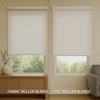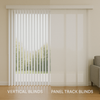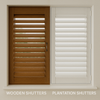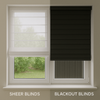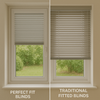Vertical Blinds for Windows: The Complete 2025 Buyer's Guide
- by Giorgi Gogidze

Vertical blinds remain one of the most practical and versatile window treatments available today. Whether you're looking to control light in a living room, add privacy to sliding glass doors, or create a professional atmosphere in an office space, vertical blinds offer functionality that's hard to beat. This comprehensive guide will walk you through everything you need to know about choosing, buying, and installing vertical blinds in 2025.
[toc]
What Are Vertical Blinds?
Vertical blinds consist of individual slats (called vanes or louvers) that hang vertically from a track system mounted above your window. Unlike horizontal blinds that tilt up and down, vertical blinds rotate left and right, and can be drawn to one or both sides of the window. This design makes them particularly effective for large windows, sliding doors, and wide openings.
Why Choose Vertical Blinds?
Light Control Excellence Vertical blinds provide superior light control compared to many other window treatments. You can adjust the angle of the vanes to filter light throughout the day, block harsh sunlight, or open them completely for maximum natural light.
Privacy When You Need It The ability to angle the vanes gives you precise privacy control. You can maintain your view while preventing others from seeing inside, or close them completely for total privacy.
Space Efficiency Unlike curtains that require clearance to open and close, vertical blinds stack neatly to one side, making them ideal for tight spaces or areas where you need maximum window access.
Low Maintenance Most vertical blind materials are easy to clean and maintain, requiring only occasional dusting or light washing.
Types of Vertical Blind Materials
Fabric Vertical Blinds
Fabric vanes offer the widest variety of colors, patterns, and textures. They provide excellent light filtering and can complement virtually any decor style. However, they may require more careful cleaning and can fade over time with direct sunlight exposure.
Best for: Living rooms, bedrooms, and spaces where aesthetics are a priority
Vinyl Vertical Blinds
Vinyl is the most budget-friendly option and offers excellent durability and moisture resistance. They're easy to clean and maintain, making them practical for high-traffic areas. The trade-off is fewer design options compared to fabric.
Best for: Kitchens, bathrooms, offices, and rental properties
Aluminum Vertical Blinds
Aluminum vanes are lightweight, durable, and offer a sleek, modern appearance. They're excellent for light control and easy to clean, though they can create more noise when opening and closing compared to fabric options.
Best for: Modern homes, offices, and contemporary spaces
Wood and Faux Wood Vertical Blinds
These premium options provide a sophisticated, natural appearance that works well with traditional and transitional decor. Real wood requires more maintenance but offers authentic beauty, while faux wood provides the look with better moisture resistance.
Best for: Formal living spaces, home offices, and upscale interiors
Key Features to Consider
Vane Width
Vertical blinds typically come in 3.5-inch or 4-inch widths. Wider vanes provide better coverage with fewer pieces, creating a cleaner look, while narrower vanes offer more flexibility in light control.
Track Systems
Look for smooth-operating tracks with quality bearings. Premium tracks include features like cord tensioners, wand controls, and quiet operation mechanisms.
Control Options
-
Cord and chain: Traditional and reliable
-
Wand control: Eliminates dangling cords for child safety
-
Motorized: Convenient remote or smart home control
Light Filtering vs. Blackout
Consider whether you need light-filtering vanes that allow some light through or blackout options for complete darkness.
Measuring for Vertical Blinds
Inside Mount Measure the width and height of the window frame's interior. Take measurements at the top, middle, and bottom for width, and left, center, and right for height. Use the smallest measurements to ensure proper fit.
Outside Mount Measure the area you want to cover, typically extending 2-3 inches beyond the window frame on each side and 4-6 inches above the frame for optimal coverage.
Installation Considerations
DIY vs. Professional Installation Most vertical blinds come with detailed installation instructions and can be installed by homeowners with basic tools. However, consider professional installation for:
-
Very large or heavy blinds
-
Multiple windows
-
Difficult-to-reach locations
-
When precise measurements are critical
Mounting Options
-
Ceiling mount: Provides maximum coverage and makes windows appear larger
-
Wall mount: Standard option that works for most situations
-
Inside mount: Creates a clean, built-in appearance
What to Expect in 2025
Smart Home Integration More vertical blind manufacturers are offering smart home compatibility, allowing you to control blinds through voice commands, smartphone apps, or automated schedules.
Sustainable Materials Eco-friendly options made from recycled materials or sustainably sourced wood are becoming more prevalent as environmental consciousness grows.
Enhanced Customization Expect more options for custom colors, patterns, and textures, including digital printing technology that allows for photo-realistic designs.
Improved Hardware Manufacturers continue to refine track systems for quieter operation, smoother movement, and increased durability.
Maintenance and Care
Regular Cleaning Dust vanes weekly with a soft cloth or vacuum brush attachment. For deeper cleaning, most vinyl and aluminum vanes can be wiped with a damp cloth.
Fabric Care Fabric vanes may require professional cleaning or gentle hand washing, depending on the material. Always check manufacturer guidelines.
Track Maintenance Periodically clean the track system and lubricate moving parts according to manufacturer instructions to ensure smooth operation.
Budget Considerations
Entry Level ($50-$150) Basic vinyl or aluminum blinds suitable for standard-sized windows. Good for rentals or temporary solutions.
Mid-Range ($150-$400) Higher-quality materials, better hardware, and more style options. Suitable for most homes and long-term use.
Premium ($400-$800+) Custom materials, motorization, smart features, and professional installation. Investment-quality blinds for permanent installations.
Common Mistakes to Avoid
Incorrect Measurements Always double-check measurements and consider whether you want inside or outside mounting before ordering.
Ignoring Room Function Choose materials appropriate for the room's moisture levels and traffic patterns.
Overlooking Safety Features If you have children or pets, prioritize cordless options or proper cord management systems.
Skipping Quality Hardware Cheap tracks and hardware can make even expensive vanes operate poorly and wear out quickly.
Final Recommendations
Vertical blinds offer an excellent combination of functionality, style, and value when chosen correctly. Focus on quality materials that match your room's needs, invest in good hardware for smooth operation, and don't forget to consider safety features for your household.
Whether you're updating a single window or outfitting an entire home, vertical blinds provide the versatility and control that make them a smart choice for 2025 and beyond. Take time to consider your specific needs, measure carefully, and choose materials that will serve you well for years to come.
The right vertical blinds will not only enhance your windows' functionality but also contribute to your home's overall comfort and aesthetic appeal. With the information in this guide, you're well-equipped to make an informed decision that you'll be satisfied with for years to come.

